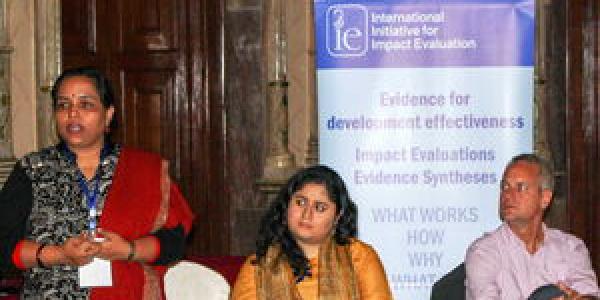Improving adolescent lives in South Asia

Improving adolescent lives in South Asia
At the 2015 Kathmandu conclave for evaluators, 3ie moderated a panel on improving adolescents' lives in South Asia, which included panellists from Breakthrough, Catalyst Management Services and UNICEF. The panellists highlighted adolescence as the critical formative years when gendered social attitudes and power relations and perceptions take shape and drive their behaviours as adults. To change existing unequal gender norms and for that change to be sustainable, it is crucial that gendered attitudes among adolescents change. There was an assessment of the steps being taken to understand gender-based inequality and current interventions on the ground. Panellists agreed that a multi-level, multi-actor nuanced approach is required to reduce gendered marginalisation and discrimination.
The panelists: Leena Sushant (Breakthrough), Urvashi Wattal (Catalyst Management Services) and Urs Nagel (UNICEF)
According to the World Bank, ‘One fifth of the population in South Asia is between the ages of 15 and 24. India alone has some 200 million young people. This is the largest number of young people ever to transition into adulthood, both in South Asia and in the world as a whole.’
Not surprising therefore that improving lives of adolescents is a key policy challenge in the region. At a recently concluded evaluation conclave in Kathmandu, 3ie organised a panel to understand the complexity of issues facing adolescents to narrow down some effective programmatic strategies to address the challenges, especially those around sexuality and unequal gendered roles and relations.
The panel moderated by 3ie’s Jyotsna (Jo) Puri, included Leena Sushant (Breakthrough), Urvashi Wattal (Catalyst Management Services) and Urs Nagel (UNICEF). The panellists highlighted adolescence as the critical formative years when gendered social attitudes and power relations and perceptions take shape and drive their behaviours as adults. To change existing unequal gender norms and for that change to be sustainable, it is crucial that gendered attitudes among adolescents change.
Breakthrough is working with adolescents in Haryana, one of the most patriarchal and feudal states of India, to help them have a voice in the decisions that affect them directly. This has meant first understanding the gendered roles, as internalised by young boys and girls. Catalyst Management Services (CMS) did a qualitative study for Breakthrough to understand gender-based behavioural traits among boys and girls, their unequal access to resources, gender relations and any forms of discrimination faced.
CMS used inquiry methods like body mapping2 and polling booth3 to help adolescents articulate what they thought were their roles and responsibilities in family and society, and what behavioural traits were valued in each sexes’ conduct. While girls, who participated in the study viewed themselves as nurturers, the boys felt it was fine for them to be wayward and misbehave with girls. Interestingly, girls emphasised obedience and purity in their conduct as characteristics that define them. The study also found that boys were also favoured by families, including receiving more affection from mothers and better access to resources, such as more and better food, mobile phones and even better medical treatment. Girls listed restrictions imposed on them and lack of access to resources as critical factors that defined them as being different from boys.
CMS’ study also provided Breakthrough with vital insights on creating an environment where female and male adolescents could exercise their rights and voice their grievances. A critical component of fostering such an environment is building capacity of boys and girls, using tools like digital media to begin discussions around subjects that are otherwise taboo.
Similarly, UNICEF is working to create a community dialogue in Afghanistan, India and Pakistan to delay marriage and pregnancy among adolescent girls and increase school enrolments. They are using a multi-pronged approach to intervene at various levels of the societal hierarchy, because the issue is complex and firmly entrenched in the larger social fabric. This approach involves not only adolescents, but also family and community leaders, and service providers that can counsel and guide young boys and girls on issues of sex, marriage, nutrition and education. Over the next five years, UNICEF hopes to reach out to approximately 10 million people across these three countries. Tackling gender-based inequality requires a multi-level, multi-actor approach, as it starts very early in life. Reducing gendered marginalisation and discrimination needs to involve not only adolescents directly, but also families and wider society, due to the intertwined nature of relationships and how these work in complex ways to reinforce and perpetuate inequality.
(Stuti Tripathi is Evaluation system specialist- NRLM)